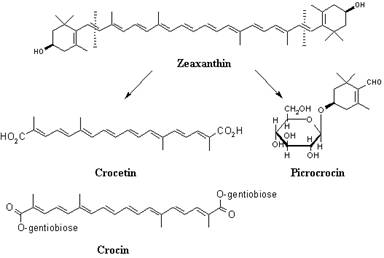Posted September 20, 2011: by Bill Sardi
Modern medicine is getting tantalizingly closer to curing cancer in the true sense of the word. The announcement that germ/tumor-fighting T-cells have recently been genetically “weaponized” and then instilled back into 3 leukemia patients with near or total 1-year remissions has hit the news media in recent days. It is a thrilling moment in the history of medicine.
So the most recent announced cancer cure is also a stunner — that an extract (crocin) from crocus, the autumn-flowering perennial plant (Crocus sativus), from which golden-yellow saffron spice is derived, can be re-engineered to ignite a fuse that destroys blood vessels that feed growing tumors, but only after it has entered a tumor cell, not before.
This drug has a molecular tail added to it which is nipped off by natural enzymes that only exist within tumors, thus making this a tumor-specific treatment that does not harm healthy cells. Its mechanism is pretty well understood now.
This stealth bomb avoids all layers of tumor resistance to shut off blood supply to tumors and in early studies eradicates tumors sometimes in just one treatment. In animals it has been shown to attack and destroy blood vessels that feed all types of tumors whether they are located in the lungs, colon, breast, prostate or elsewhere.
The problem here is, while treatments in the animal lab show this type of therapy reduces tumors by 50-70% or more after initial treatment, killing cancer cells does not equate with survival. Chemotherapy drugs are approved if they whittle down tumors by 50% or more, but their action is toxic and often leads to the earlier demise of patients.
However, it should be said that crocus extract has been shown to prolong the life of tumor-bearing animals. In one experiment, if crocus extract were given to animals prior to induction of tumors, there was a 58% increase in lifespan and a 95.6% reduction of solid tumor in crocin-treated animals on the 31st day after tumor inoculation. 20104983 When added to an existing anti-cancer drug it produced complete remissions in the animal lab.
Saffron has been reported to have anti-cancer properties for a number of years now. One published report dates back to 1991. Modern medicine works at an agonizingly slow pace, particularly for patients and their families battling active cases of cancer.
If anyone wants to produce their own home remedy using saffron they should be advised that very high concentrations are required to produce these anti-cancer effects in the laboratory. Saffron’s extract (crocetin) would be far more expensive than plain saffron. But nonetheless, saffron added to the diet would likely be helpful in preventing cancer.
Saffron is a pigment in the family of carotenoids (beta carotene, lutein, lycopene, zeaxanthin) and is known as the most expensive spice in the world. A 16-ounce tin of saffron sells for $1282.95 at Amazon.com

Another intriguing connection is that of resveratrol and saffron. Resveratrol, known as a red wine molecule, binds to the same site that saffron binds to as it inhibits tumor growth.
While crocetin from saffron destroys new blood vessels the feed the growth of tumors, resveratrol molecularly inhibits tumor growth by chelating copper, a primary growth factor, and by inhibiting VEGF (vascular endothelial growth factor) and HIF (hypoxia inducing fator) genes in what is a non-toxic approach to cancer control. Remarkably, one available resveratrol-based nutriceutical was recently shown to inhibit VEGF and HIF genes many times more than plain resveratrol in an animal study and has also demonstrated ability to inhibit new blood vessel growth in the back of human eyes, thus posing it as an untested but promising cancer cure. © 2011 Bill Sardi, Knowledge of Health, Inc. Not for posting on other websites.
Posted in Modern Medicine ; No Comments »
You must be logged in to post a comment.
11
17
52
95
14
24
237
6
56
43
10
116
15
66
105